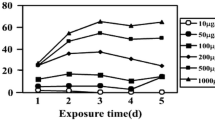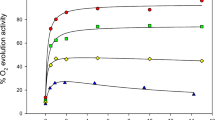Abstract
We analysed the changes of the chlorophyll (Chl)
a fluorescence rise kinetic (from 50 μs to 1 s) that occur when leaves or chloroplasts of pea ( Pisum sativum L.) are incubated under anaerobic conditions in the dark. In control leaves, Chl a fluorescence followed a typical O-J-I-P polyphasic rise [Strasser et al. (1995) Photochem Photobiol 61: 32–42]. Anaerobiosis modified the shape of the transient with the main effect being a time-dependent increase in the fluorescence yield at the J-step (2 ms). Upon prolongation of the anaerobic treatment (> 60 min), the O-J-I-P fluorescence rise was eventually transformed to an O-J (J = P) rise. A similar transformation was observed when pea leaves were treated with DCMU or sodium dithionite. Anaerobiosis resulted in a 10–20% reduction in the maximum quantum yield of the primary photochemistry of Photosystem II, as measured by the ratio of the maximal values of variable and total fluorescence (FV/FM). When the leaves were returned to the air in the dark, the shape of the fluorescence transient showed a time-dependent recovery from the anaerobiosis-induced change. The original O-J-I-P shape could also be restored by illuminating the anaerobically treated samples with far-red light but not with blue or white light. Osmotically broken chloroplasts displayed under anaerobic conditions fluorescence transients similar to those observed in anaerobically treated leaves, but only when they were incubated in a medium comprising reduced pyridine nucleotides (NADPH or NADH). As in intact leaves, illumination of the anaerobically treated chloroplasts by far-red light restored the original O-J-I-P transient, although only in the presence of methyl viologen. The results provide additional evidence for the existence of a chlororespiratory pathway in higher plant cells. Furthermore, they suggest that the J-level of the fluorescence transient is strongly determined by the redox state of the electron carriers at the PS II acceptor side.
Similar content being viewed by others
References
Arnon DI (1949) Copper enzymes in isolated chloroplasts. Polyphenoloxidase in Beta vulgaris. Plant Physiol 24: 1–15
Asada K, Heber U and Schreiber U (1993) Electron flow to the intersystem chain from stromal components and cyclic electron flow in maize chloroplasts, as detected in intact leaves by monitoring redox change of P700 and chlorophyll fluorescence. Plant Cell Physiol 34: 39–50
Bennoun P (1982) Evidence for a respiratory chain in the chloroplast. Proc Natl Acad Sci USA 79: 4352–4356
Büchel C and Garab G (1997) Respiratory regulation of electron transport in chloroplasts: chlororespiration. In Pessarakli M (ed) Handbook of Photosynthesis, pp 83–93. Marcel Dekker, New York
Burrows PA, Sazanov LA, Svab Z, Maliga P and Nixon PJ (1998) Identification of a functional respiratory complex in chloroplasts through analysis of tobacco mutants containing disrupted plastid ndh genes. EMBO J 17: 868–76
Corneille S, Cournac L, Guedeney G, Havaux M and Peltier G (1998) Reduction of the plastoquinone pool by exogenous NADH and NADPH in higher plant chloroplasts. Characterization of a NAD(P)H–plastoquinone oxidoreductase activity. Biochim Biophys Acta 1363: 59–69
Dau H (1994) Molecular mechanism and quantitative models of variable Photosystem II fluorescence. Photochem Photobiol 60: 1–23
Diner B (1977) Dependence of the deactivation reactions of Photosystem II on the redox state of plastoquinone pool A varied under anaerobic conditions. Equilibrium on the acceptor side of Photosystem II. Biochim Biophys Acta 466: 247–258
Endo T, Mi H, Shikanai T and Asada K (1997) Donation of electrons to plastoquinone by NAD(P)H dehydrogenase and ferredoxinquinone reductase in spinach chloroplasts. Pant Cell Physiol 38: 1272–1277
Feild TS, Nedbal L and Ort D (1998) Nonphotochemical reduction of the plastoquinone pool in sunflower leaves originates from chlororespiration. Plant Physiol 116: 1209–1218
Flügge U-I and Heldt HW (1991) Metabolite translocators of the chloroplast envelope. Ann Rev Plant Physiol Plant Mol Biol 42: 129–144
Garab G, Lajkó F, Mustárdy L and Márton L (1989) Respiratory control over photosynthetic electron transport in chloroplasts of higher-plant cells: Evidence for chlororespiration. Planta 179: 349–358
Govindjee (1995) Sixty-three years since Kautsky: chlorophyll a fluorescence. Aust J Plant Physiol 22: 131–160
Groom QJ, Kramer DM, Crofts A and Ort D (1993) The nonphotochemical reduction of plastoquinone in leaves. Photosynth Res 36: 205–215
Guissé B, Srivastava A and Strasser RJ (1995) Effect of high temperature and water stress on the polyphasic chlorophyll a fluorescence transient of potato leaves. In: Mathis P (ed) Photosynthesis: From Light to the Biosphere, Vol IV, pp 913–916. Kluwer Academic Publishers, Dordrecht, The Netherlands
Harris GC and Heber U (1993) Effects of anaerobiosis on chlorophyll fluorescence yield in spinach (Spinacia oleracea) leaf discs. Plant Physiol 101: 1169–1173
Joliot P, Lavergne J and Béal D (1992) Plastoquinone compartmentation in chloroplasts. I. Evidence for domains with different rates of photo-reduction. Biochim Biophys Acta 1101: 1–12
Kaulsky H and Hirsch A (1931) Neue Versuche zur Kohlensäuereassimilation. Naturwissenshaften 48: 964
Karukstis KK (1991) Cholorophyll fluorescence as a physiological probe of the photosynthetic apparatus. In: Scheer H (ed) Chlorophyll, pp 769–795. CRC Press, Boca Raton, FL
Kofer W, Koop HU, Wanner G and Steinmuller K (1998) Mutagenesis of the genes encoding subunits A, C, H, I, J and K of the plastid NAD(P)H–plastoquinone-oxidoreductase in tobacco by polyethylene glycol-mediated plastome transformation. Mol Gen Genet 258: 166–173
Krause GH and Weis E (1991) Chlorophyll fluorescence and photosynthesis: the basics. Ann Rev Plant Physiol Plant Mol Biol 42: 313–349
Mills JD, Crowther D, Slovacek RE, Hind G and McCarty RE (1979) Electron transport pathways in spinach chloroplasts. Reduction of the primary acceptor of Photosystem II by reduced nicotinamide adenine dinucleotide phosphate in the dark. Biochim Biophys Acta 547: 127–137
Neubauer C and Schreiber U (1987) The polyphasic rise of chlorophyll fluorescence upon onset of strong continuous illumination: I. Saturation characteristics and partial control by Photosystem II acceptor side. Z Naturforsch 42c: 1246–1254
Oettmeier W (1992) Herbicides of Photosystem II. Topics in Photosynthesis 11: 349–408
Peltier G, Ravenel J and Verméglio A (1987) Inhibition of a respiratory activity by short saturating flashes in Chlamydomonas: evidence for a chlororespiration. Biochim Biophys Acta 893: 83–90
Ravenel J and Peltier G (1992) Stimulation of the chlororespiratory electron flow by photosystem II activity in Chlamydomonas reinhardtii. Biochim Biophys Acta 1101: 57–63
Sazanov LA, Burrows PA and Nixon PJ (1998a) The chloroplast Ndh complex mediates the dark reduction of the plastoquinone pool in response to heat stress in tobacco leaves. FEBS Lett 429: 115–118
Sazanov LA, Burrows PA and Nixon PJ (1998b) The plastid ndh genes code for an NADH-specific dehydrogenase: isolation of a complex I analogue from pea thylakoid membranes. Proc Natl Acad Sci USA 95: 1319–1324
Scherer S (1990) Do photosynthetic and respiratory electron transport chains share redox proteins? TIBS 15: 458–462
Schreiber U and Bilger W (1993) Progress in chlorophyll fluorescence research: major developments during the past years in retrospect. Progress in Botany 54: 151–173
Schreiber U and Neubauer C (1987) The polyphasic rise of chlorophyll fluorescence upon onset of strong continuous illumination: II Partial control by Photosystem II donor side and possible ways of interpretation. Z Naturforsch 42c: 1255–1264
Singh KK, Chen C and Gibbs M (1992) Characterization of an electron transport pathway associated with glucose and fructose respiration in the intact chloroplasts of Chlamydomonas reinhardtii and spinach. Plant Physiol 100: 327–333
Shinozaki K, Ohme M, Tanaka M, Wakasugi T, Hayashida N, Matsubayashi T, Zaita N, Chunwongse J, Obokata J, Yamaguchi-Shinozaki K, Ohto C, Torozawa K, Meng BY, Sugita M, Deno H, Kamogashira T, Yamada K, Kusuda J, Takaiwa F, Kata A, Tohdoh N, Shimada H and Sugiura M (1986) The complete nucleotide sequence of the tobacco chloroplast genome: its gene organization and expression. EMBO J 5: 2043–2049
Srivastava A, Strasser RJ and Govindjee (1995) Polyphasic rise of chlorophyll a fluorescence in herbicide-resistant D1 mutants of Chlamydomonas reinhardtii. Photosynth Res 43: 131–141
Srivastava A, Guissé B, Greppin H and Strasser RJ (1997) Regulation of antenna structure and electron transport in Photosystem II of Pisum sativum under elevated temperature probed by the fast polyphasic chlorophyll a fluorescence transient: OKJIP. Biochim Biophys Acta 1320: 95–106
Stirbet A, Govindjee, Strasser BJ and Strasser RJ (1998) Chlorophyll a fluorescence induction in higher plants: Modelling and numerical simulation. J Theor Biol 193: 131–151
Strasser RJ (1978) The grouping model of plant photosynthesis. In: Akoyunoglou G et al. (eds) Chloroplast Development, pp 513–524. Elsevier, Amsterdam
Strasser RJ and Govindjee (1991) The Fo and the O-J-I-P fluorescence rise in higher plants and algae. In: Argyroudi-Akoyunoglou JH (ed) Regulation of Chloroplast Biogenesis, pp 423–426. Plenum Press, New York
Strasser RJ and Govindjee (1992) On the O-J-I-P fluorescence transients in leaves and D1 mutants of Chlamydomonas reinhardtii. In: Murata N (ed) Research in Photosynthesis, Vol II, pp 29–32. Kluwer Academic Publishers, Dordrecht, The Netherlands
Strasser RJ, Srivastava A and Govindjee (1995) Polyphasic chlorophyll a fluorescence transient in plants and cyanobacteria. Photochem Photobiol 61: 32–42
Strasser RJ and Tsimilli-Michael M (1998) Activity and heterogeneity of PS II probed in vivo by the chlorophyll a fluorescence rise O-(K)-J-I-P. In: Garab G (ed) Photosynthesis: Mechanisms and Effects, Vol V, pp 4321–4324. Kluwer Academic Publishers, Dordrecht, The Netherlands
Sugiura M (1992) The chloroplast genome. Plant Mol Biol 19: 149–168
Trebst A (1991) The molecular basis of resistance of Photosystem II herbicides: In: Caseley JC Cussans GW and Aktins RK (eds) Herbicides Resistance in Weeds and Crop, pp 145–164. Butterworth-Heinemann, Oxford
Author information
Authors and Affiliations
Corresponding author
Rights and permissions
About this article
Cite this article
Haldimann, P., Strasser, R.J. Effects of anaerobiosis as probed by the polyphasic chlorophyll a fluorescence rise kinetic in pea (Pisum sativum L.). Photosynthesis Research 62, 67–83 (1999). https://doi.org/10.1023/A:1006321126009
Issue Date:
DOI: https://doi.org/10.1023/A:1006321126009




